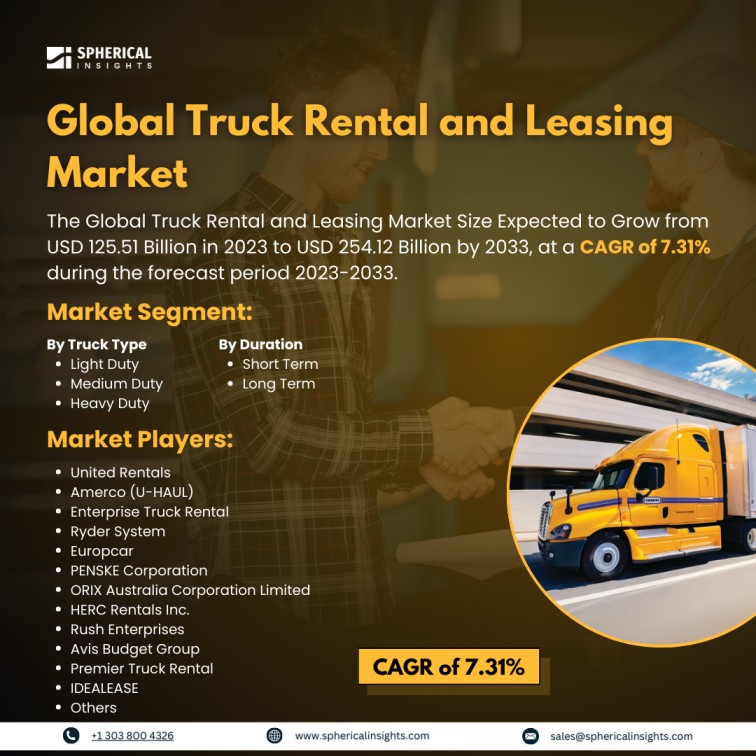Global Truck Rental and Leasing Market Size to Exceed USD 254.12 Billion by 2033
According to a research report published by Spherical Insights & Consulting, the Global Truck Rental and Leasing Market Size Expected to Grow from USD 125.51 Billion in 2023 to USD 254.12 Billion by 2033, at a CAGR of 7.31% during the forecast period 2023-2033.
Browse 210 market data Tables and 45 Figures spread through 190 Pages and in-depth TOC on the Global Truck Rental and Leasing Market Size, Share, and COVID-19 Impact Analysis, By Truck Type (Light Duty, Medium Duty, and Heavy Duty), By Duration (Short Term and Long Term), and By Region (North America, Europe, Asia-Pacific, Latin America, Middle East, and Africa), Analysis and Forecast 2023 – 2033
The market for truck rental and leasing includes the short-term or long-term renting and leasing of trucks for a range of uses, including business use, home moving, and freight transportation. The truck rental business is expanding as a result of the burgeoning e-commerce sector. Efficient last-mile delivery solutions are becoming more and more necessary as online purchasing continues to grow. Companies, particularly small and medium-sized businesses (SMEs), favor truck rentals over fleet purchases because they are more flexible and affordable. The demand for both short-term and long-term truck rentals has steadily increased as a result of this trend, especially in cities with dense distribution networks. Additionally, truck rental services give companies the freedom to grow without having to make the long-term commitment to buy and manage a fleet. By lowering the costs associated with car ownership, such as maintenance, insurance, and depreciation, renting enables businesses to better handle varying demands. Truck rental services are becoming more and more popular across a range of industries due to their cost effectiveness, which is especially alluring to companies with seasonal demand patterns or those with narrow profit margins. However, truck maintenance, fuel, insurance, and depreciation raise operating costs, which can be very costly for rental businesses.
The light-duty segment held the highest share in 2023 and is anticipated to grow at a significant CAGR during the projected timeframe.
Based on the truck type, the global truck rental and leasing market is categorized as light duty, medium duty, and heavy duty. Among these, the light-duty segment is expected to hold the largest share of the global truck rental and leasing market during the projected timeframe. Light-duty trucks are effective, incredibly adaptable, and frequently employed for private tasks like moving household products and small items. They are also used in commercial contexts as service cars or for delivery in cities.
The short-term segment held the highest share in 2023 and is anticipated to grow at a significant CAGR during the projected timeframe.
Based on the duration, the global truck rental and leasing market is categorized as short-term and long- term. Among these, the short-term segment is expected to grow at the fastest CAGR during the projected timeframe. Renting a truck for a few days or months gives you more flexibility and allows you to react swiftly to changing needs or demands. Short-term rental is defined as less than six months.
North America is projected to hold the largest share of the global truck rental and leasing market over the forecast period.
North America is projected to hold the largest share of the global truck rental and leasing market over the forecast period. The economies of several Asia-Pacific nations have been expanding rapidly, which has raised business and industrial activity. As businesses grow, they frequently look for flexible transportation options, which makes renting medium- and heavy-duty commercial vehicles appealing. The need for transportation services within cities and metropolitan areas has increased as a result of growing regional urbanization. The demand for rental services will also rise as a result of rising construction expenditures.
North America is expected to grow at the fastest CAGR growth of the global truck rental and leasing market during the forecast period. The region's market is being driven by a firmly established industrial sector. Throughout the region, small and mid-sized businesses are choosing to use leasing services for their transportation-related operations. Rental services are often used by small and medium-sized transportation enterprises in their daily operations. The market is supported by the existence of significant regional players. Trucking is becoming a more popular means of transportation due to the region's strong transportation infrastructure.
Competitive Analysis
Major vendors in the global truck rental and leasing market are United Rentals, Amerco (U-HAUL), Enterprise Truck Rental, Ryder System, Europcar, PENSKE Corporation, ORIX Australia Corporation Limited, HERC Rentals Inc., Rush Enterprises, Avis Budget Group, Premier Truck Rental, Barco Rent-A-Truck, Driving Force, IDEALEASE., and others.
Key Target Audience
- Market Players
- Investors
- End-users
- Government Authorities
- Consulting and Research Firm
- Venture capitalists
- Value-Added Resellers (VARs)
Key Market Developments
- In February 2024, Mercedes-Benz, a well-known German automaker, declared its intention to enter the Brazilian truck rental market. The business made the decision to take advantage of the skyrocketing cost of new cars, which is driving up demand for leasing and rental services.
Market Segment
This study forecasts revenue at global, regional, and country levels from 2020 to 2033. Spherical Insights has segmented the global truck rental and leasing market based on the below-mentioned segments:
Global Truck rental and leasing Market, By Truck Type
- Light Duty
- Medium Duty
- Heavy Duty
Global Truck rental and leasing Market, By Duration
Global Truck rental and leasing Market, By Regional
- North America
- Europe
- Germany
- UK
- France
- Italy
- Spain
- Russia
- Rest of Europe
- Asia Pacific
- China
- Japan
- India
- South Korea
- Australia
- Rest of Asia Pacific
- South America
- Brazil
- Argentina
- Rest of South America
- Middle East & Africa
- UAE
- Saudi Arabia
- Qatar
- South Africa
- Rest of the Middle East & Africa



